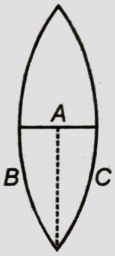Two convex lenses of focal lengths are separated co-axially by a distance d. The power of the combination will be zero if d equals to
1.
2.
3.
4.
In the following diagram what is the distance x if the radius of curvature R=15 cm?

(1) 30 cm
(2) 20 cm
(3) 15 cm
(4) 10 cm
A thin equiconvex lens of power P is cut into three parts A, B, and C as shown in the figure. If are powers of the three parts respectively, then

1.
2.
3.
4.
In the diagram shown below, the image of the point object O is formed at l by the convex lens of focal length 20 cm, where are foci of the lens. The value of x' is

(1) 10 cm
(2) 20 cm
(3) 30 cm
(4) 40 cm
An astronomical telescope has angular magnification of \(40\) in its normal adjustment. If focal length of eyepiece is \(5\) cm, the length of the telescope is:
1. \(190\) cm
2. \(200\) cm
3. \(205\) cm
4. \(210\) cm
In case of refraction through a glass slab, if i is very small, the lateral shift is (t is thickness, u is the refractive index)
1.
2.
3.
4.
The angle of a distant object formed at the objective of a telescope is 2 minutes. If the focal length of objective and eyepiece of the telescope is 200 cm and 20 cm, then the size of the image formed by the objective is approximately
1. 20 cm
2. 0.12 cm
3. 0.4 cm
4. 12 cm
| 1. | \(60~\text{cm}\) | 2. | \(120~\text{cm}\) |
| 3. | \(30~\text{cm}\) | 4. | \(180~\text{cm}\) |
The condition of minimum deviation is achieved in an equilateral prism kept on the prism table of a spectrometer. If the angle of incidence is \(50^{\circ}\), the angle of deviation is:
1. \(25^{\circ}\)
2. \(40^{\circ}\)
3. \(50^{\circ}\)
4. \(60^{\circ}\)
A small air bubble is at the centre of a glass sphere of radius 10 cm and refractive index 1.5. The distance of the bubble from the surface, when viewed from outside the sphere, is
(1) 2.5 cm
(2) 5 cm
(3) 7.5 cm
(4) 10 cm






